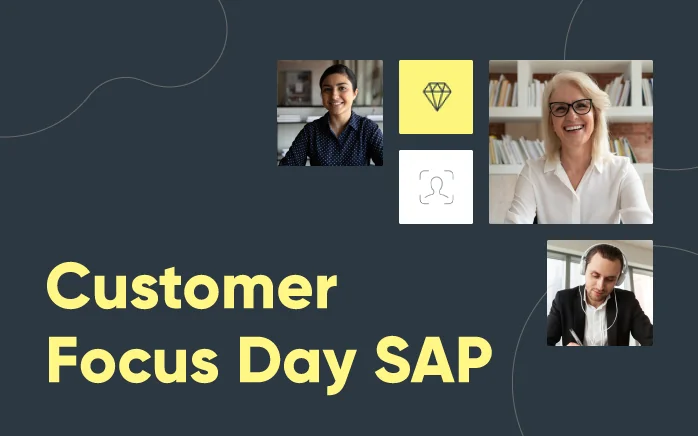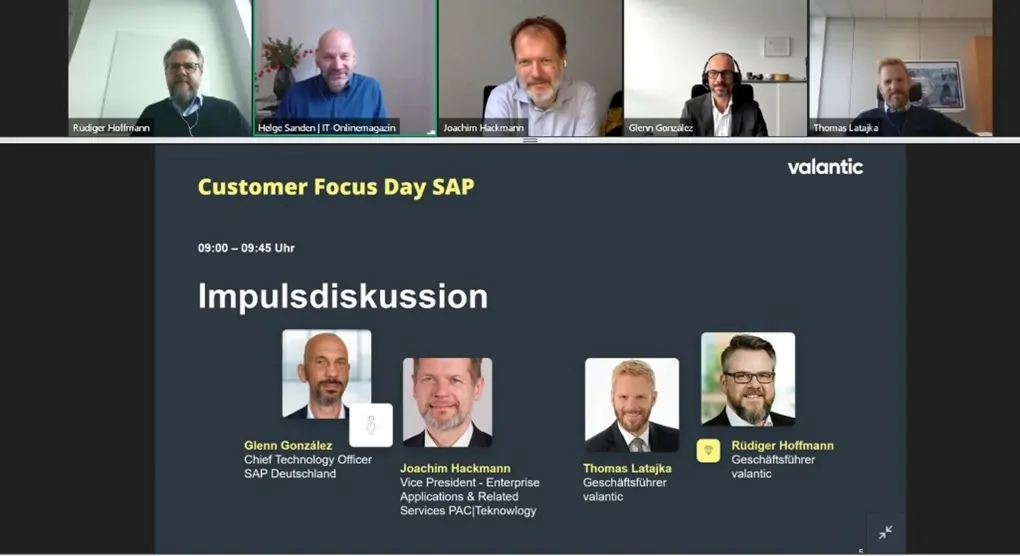Catalysts for a successful company
October 15, 2020

October 15, 2020

Companies want to update their individual SAP strategy, automate business processes, implement new digital business models, and make their IT flexible and more agile. The valantic Customer Focus Day SAP showed them how they can do these things successfully and what the catalysts are.
The Customer Focus Day SAP, which valantic organized for the first time virtually at the beginning of October, was chock full of solution strategies and practical cases for challenges with which every company is confronted today. Process optimization, cloud, integrated planning, artificial intelligence, and end-to-end automation are some of the things that companies today have to adjust carefully in order to remain successful on the market tomorrow. “Digital technologies have increased the speed of change enormously and without a foundation that works well, companies can no longer function properly,” emphasized Glenn González, CTO of SAP Deutschland, in the keynote speech that opened the Customer Focus Day and provided the thematic impulses for the following topic sessions, customer studies, and expert discussions.

SAP’s in-memory platform S/4HANA doesn’t play the only role in the digital transformation, but its role is decisive. According to a survey of the German-speaking SAP users’ group DSAG, 70 to 80% of SAP customers are ready to to tackle migration to the new platform. And they have to do this, for support for the old R/3 and for ECC 6.0 will be discontinued by 2030. However, migration is not a sure-fire success and should be done according to a clearly defined strategy plan. “First, customers have to do their homework; that is, create the basis for introducing S/4HANA, otherwise the project is doomed to failure,” explains valantic Managing Director Thomas Latajka. For this does not just involve technology, it’s not a purely technical update to a new platform. “In the long run, we will be living out a transformation process, and the readiness to engage with this process will determine success or failure,” says Rüdiger Hoffman, Managing Director of Linkit – a valantic company. In the long term, a new mindset is required, and this can only work top-down: The top management has to exemplify the digital transformation and bring along the whole organization with all its employees.
Cheese producer Hochland uses “Discovery & Delivery” methodology
Jürgen Brunner, IT Department Manager at the Hochland Group, has successfully started the migration to S/4HANA. Hochland SE, headquartered in Heimenkirch in the Allgäu, is a food producer and one of the largest cheese producers in Europe. “We have been using SAP R/3 for 20 years and, after careful consideration, we have selected a greenfield approach. S/4HANA will create the basis for the challenges with which we will be confronted in the years to come,” reports Brunner. With a greenfield approach, you’re starting largely from scratch with SAP and you can also use the migration to automate and optimize processes end-to-end. However, we will also use brownfield from time to time. Without a strong partner and consultants, we could hardly manage such a complex project. “We organized a ‘beauty contest’ and selected valantic as our partner,” explains Brunner. Most crucial here were valantic’s expertise and experience with S/4 projects, but the chemistry and gut feeling also have to be right.
Hochland handled the project with a “continuous discovery & delivery” methodology. The procedure at a glance: The discovery team specifies the integration and subprocesses in one-month sprints and transfers them to the delivery team, which implements the specifications and reflects the results back to discovery. “Thanks to the close coupling of discovery and delivery, we avoid unnecessary friction losses and we can succeed in keeping all employees’ attention trained on the project,” explains valantic Managing Director Latajka about the benefits of this methodology.
IT Department Manager Brunner draws a positive conclusion: “I’m very proud that we at Hochland have been able to work with valantic to blaze this courageous trail. We still have to fine-tune a few things, but currently most of the sub-projects are ongoing, some are almost completed.” Brunner sees S/4HANA as an essential component of Hochland’s entrepreneurial vision, which rests on five pillars: Growth, sustainability, increased efficiency, digitalization, and attractiveness for employees. He especially emphasizes the last, fifth pillar: It’s critical, with the support of the executive board, to “pick up” the employees, train them, and lead them toward the new digital technologies.
Securing efficiency benefits with RPA
The market pressure to achieve high-quality results with limited resources is advancing the automation of production and business processes. Predestined for this are routine tasks, which can be performed efficiently, cost-effectively, and error-free with robotic process automation. Therefore, a technical update to SAP S/4HANA is frequently not enough for customers. “Many customers also want to put their processes on the test bench, but they are afraid of the time-consuming and expensive greenfield approach,” reports Hoffman. However, a lean brownfield approach, which adjusts the old SAP system to the new SAP S/4HANA Business Suite, does not always produce the desired success. That’s why Linkit Managing Director Guido Czampiel advises: “Forget brownfield, forget greenfield. A hybrid project methodology that combines the best of both worlds is the silver bullet for a S/4 migration project.”
Don't miss a thing.
Subscribe to our latest blog articles.